Gas Dynamics &
|
Shock Interactions and Detached ShocksMany supersonic applications arise involving oblique shocks. These include reflection of shocks from solid walls, intersection of shocks, shocks produced by high speed vehicles, etc. Shock Reflection from a WallA first application is an oblique shock impinging on wall at an angle $β$ as shown in Fig. 37. This oblique shock could be the result of a wedge being placed in a supersonic flow at a Mach Number, $M_1$. The flow is deflected through an angle $θ$. The presence of the wall at the bottom redirects the flow back to the horizontal. This produces a reflected shock inclined to the wall at an angle $β'$. While the flow deflection angles are equal an opposite, the angle of the reflected wave is not necessarily equal that of the incident wave. They would only be the same if the waves were Mach Waves and haven't deflected the flow. The Mach numbers are different infront of each wave so the oblique wave anges are different for a similar turning anlge. Incident shock is generated in a flow where the Mach number is $M_1$ while the reflected shock is generated where the Mach Number is $M_2$ . 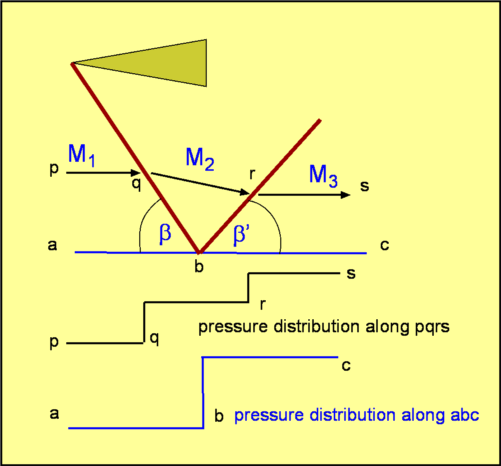 Figure 37 : Shock reflection from a wall The resulting flow properties and pressure distribution as shown in the figure can be calculated easily by applying the previous oblique wave results to both waves in sequence. Intersection of two ShocksIntersection of two shocks occurs when they interact with each other at an angle as shown in Fig. 38. If the shocks are of equal strength, the interaction takes place as if each of the shocks is reflected off the centreline of the flow, which is in fact a streamline. A streamline can always be treated as a wall so that the calculation procedure is identical to that for a single shock reflection. 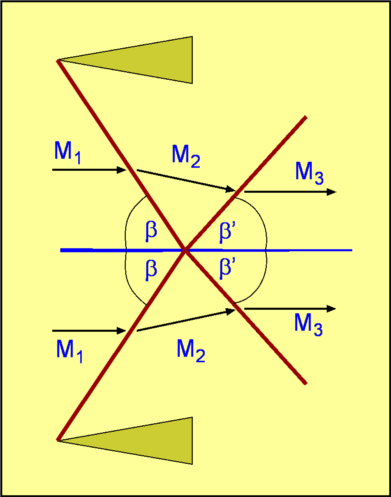 Figure 38 : Intersection of two symmetric Shocks When the shocks are of unequal strength, then the flow field loses symmetry. A new feature appears downstream of the interaction, Fig. 39. This is called a Slip Stream. This divides the flow into two parts - (1) flow which has been processed by shocks on top and (2) flow processed by the shocks at the bottom. The slip stream is such that the pressure, $P_3$ and the flow angle $δ$ are continuous across it. Density, temperature and other properties will be different. To solve this situation an iterative process is required so that the pressure is equal on either side of the slipstream. 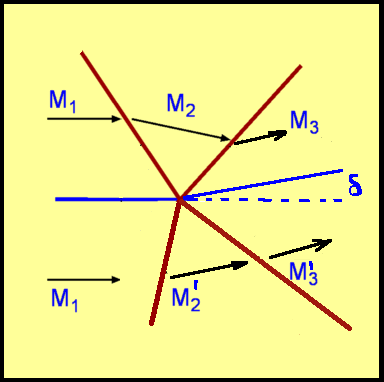 Figure 39 : Intersection of two non-symmetric Shocks Strong Solutions - Detached ShocksAnother case is where the flow is impacting a body whose nose is such that $θ > θ_{max}$ (where $θ_{max}$ is the maximum allowed flow deflection angle as calculated in the previous section on oblique shock waves). In this case the shock is not attached to the nose but stands away from it - i.e, it is Detached as shown in Fig. 40. The shock is no longer a straight line but is curved and its shape and strength depend upon $M_1$ and the geometry of the body. On the centreline the shock is a normal shock at a. Away from the centreline the shock weakens and approaches a Oblique Wave at d. From a to d a range of strong shock solutions exist. 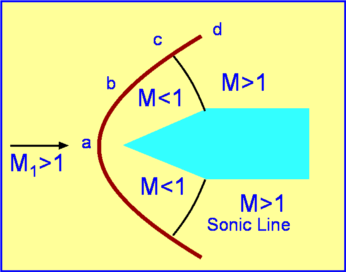 Figure 40 : Detached Shock in front of a Wedge This combination of shock wave solutions causes the flow field downstream of the shock to be somewhat complicated. The flow downstream of a normal shock is subsonic. Thus there is a subsonic patch of flow near the centreline downstream of the shock. The extent of this region depends upon the body geometry and the freestream Mach Number. Away from the centreline the shock eventually reaches a weak oblique wave solution with a supersonic flow behind it. A sonic line separates the supersonic flow from the subsonic region. If the body is blunt as shown in Fig. 41, the shock wave is detached at all Mach Numbers. 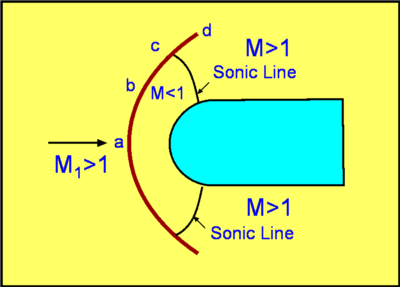 Figure 41 : Detached Shock in front of a Blunt Body The distance between the body and the shock is called Shock Stand Off Distance and it decreases with Mach number. It is possible to compute this distance using CFD techniques or experimental measurements. Mach ReflectionIn many application a simple reflection of the shock at a solid surface does not occur. It will happen when the Mach Number downstream, $M_2$ is such that a weak oblique shock solution is not possible. In these circumstances, reflection of the shock does not take place at the solid wall but a distance away from it. As shown in Fig. 42. There is now a triple point in the flow followed by a slip stream. This phenomenon is called Mach Reflection. The properties again need to calculated by iteration until pressure behind the triple point becomes equal in both downstream regions. 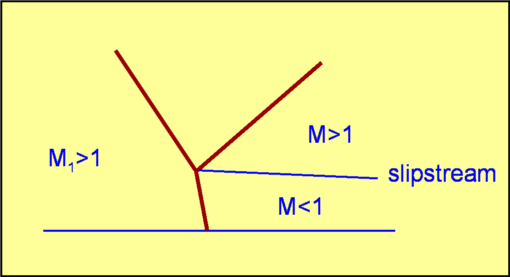 Figure 42 : Mach Reflection |